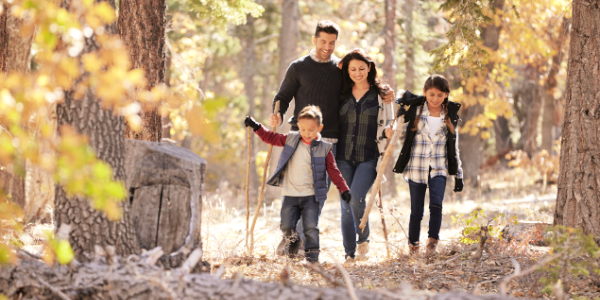
Changing fall foliage marks a clear change in the seasons and can mark a natural turning point for health habits, too. From at-home workouts to autumn health tips, there are plenty of ways to ensure wellness when the weather transitions.
Keep reading for fall health tips, including fall wellness tips for common autumn ailments like allergies.
Importance of Adopting Fall Health Tips
Fall marks a busy season for many, with back-to-school and sports crowding calendars. For others, autumn is a reminder to slow down and incorporate more "me time." In any case, prioritizing health is crucial to fully enjoying the season.
From increased travel to tempting holiday foods, it can feel overwhelming to manage your health and the health of your loved ones. Fortunately, a few simple health habits can keep wellness in mind during the fall without requiring you to relinquish too much time in your schedule.
The following tips for a healthy fall can help you take advantage of autumn's wonder.
Sustain a Healthy Fall Diet
Eating a well-balanced diet can help you stay healthy as the seasons change.
Meal Prep to Support Your Schedule
Fall marks the beginning of a busy season for many families, and planning snacks and meals can help you stay on top of it all. Prepare adequate snacks for school, sports, and shift work schedules to ensure everyone stays fueled and energized during the day's activities.
Fall crockpot recipes can also help support busy schedules and are affectionately called "set it and forget it" meals.
Eat Seasonally
Save money and eat in a nutrient-rich way by buying autumn seasonal foods. These items are at their nutritional peak during the fall and maybe foods you're already used to eating!
For example, pumpkins are in season during this time period and are a staple in fall foods—from drinks to desserts and everything in between, pumpkin recipes just hit the spot! Try using these foods in a new and more nutritious way, such as a breakfast smoothie or dinnertime soup.
Celebrate fall by incorporating more of the following fall vegetables and fruits onto your plate:
• Beets
• Cranberries
• Parsnips
• Sweet potato
• Winter squash, such as spaghetti squash or butternut squash
Increase Fiber Intake
Fiber can help you to keep up with travel and other activities since it provides sustaining, slow-burning energy. Oats are a prime example and are a versatile food that can be served hot or cold during this season of transitioning weather.
Replicate classic fall flavor combos in overnight oats, such as pumpkin pie, apple cinnamon, or maple pecan.
Convert Comfort Foods
During fall, you may find yourself craving comfort foods more frequently. While these dishes have a reputation for being carb-heavy or unhealthy, they can actually be quite a nutritious choice!
With a few healthy swaps and food substitutes, you can turn your favorite fall comfort foods into nutrient-rich dishes. For example, create healthy mac and cheese by using whole wheat macaroni and cheese crumbs in addition to reduced-fat cheese.
Consume More Vitamin C
Vitamin C won't do much for a cold you already have, but you may be able to boost your immune system, reduce symptom severity, and prevent future health threats by eating foods rich in this nutrient.
Well-known for their protective effects, you can add citrus—like lemon and lime—to both hot and cold foods for flavor. Popular uses include adding lemon juice to herbal tea or seasoning fish dishes with lemons or lime.
Other foods high in vitamin C include:
• Bell peppers
• Cruciferous vegetables—like broccoli and Brussels sprouts
• Oranges and orange juice
• Potatoes
• Strawberries
• Tomatoes
Stay Active with Weather Changes
Take solace in knowing you aren't alone—many people find it hard to stay active during the fall and winter when the weather is unpredictable and daylight hours decrease. Luckily, there are ways to stay physically active in your living room when the weather isn't exactly supportive of exercise.
Spent Time Outdoors When Possible
Autumn's sunny days are numbered, so (when possible) try and make it outside. Getting at least 15 minutes of sunlight each day has known health benefits from nutrition to mental wellness, and can help change up your workout routine to keep things from getting stale.
Spending time outdoors is generally considered safest in early fall when the weather is agreeable, and surfaces aren't slick. It's a great time to enjoy the fall season before it gets too cold for prolonged exposure to the elements.
Remember, anytime you go in the sun for more than about 20 or 30 minutes—even during cloudy or colder weather—wearing sunscreen is recommended to take care of your skin.
Walk with Friends or Family
Fall can be an exciting and eventful season, but also one that leaves many individuals feeling isolated. Walking with loved ones can turn exercise from a loathed event into a social occasion and a way to catch up on meaningful milestones.
Plus, walking with a buddy can ensure you're accompanied in the case of slips, falls, or accidents when walking surfaces—like roads and sidewalks—get icy.
Consider At-Home Classes
Thanks to the internet and apps, many exercise programs are available at your fingertips. From free Youtube videos to paid subscriptions, many options for physical activity can meet you where you are at.
When the weather won't budge, opt for at-home movement methods to get your heart rate going. Fun-sized fitness habits known—or "exercise snacks"—are also a great way to fit movement more effortlessly into your day!
Manage Fall Allergies and Colds
Colds and flu run rampant during fall and can be especially threatening if you travel for the holidays. Protect yourself and your loved ones with these simple steps and safety measures.
Wash Your Hands
Although it may sound simple, washing your hands is one of the best ways to protect yourself from viruses and bacteria that easily spread in the fall. The Centers for
Disease Control and Prevention have free printable posters available to place in common areas at school, work, or home. This can be a fun and lighthearted way to discuss a serious safety measure with kids, coworkers, and other community members.
Stay Up-to-Date on Vaccinations
Since environments—like schools—place people in close quarters, it's important to keep your family's vaccinations up-to-date.
Chiefly, getting the flu vaccine each year can help protect you against common strains of the influenza virus. The flu shot is usually recommended for everyone older than 6 months.
However, immunocompromised individuals, vulnerable populations (such as the elderly), or allergic individuals may need to consult their healthcare team for alternate forms of the vaccine or strategies for avoiding sickness.
Consider Natural Remedies for Fall Allergies
Fall allergies are common, but so are many home remedies for allergies! While they vary in effectiveness, home remedies are relatively safe and generally low-risk when conducted according to the direction of health experts.
Work with a qualified holistic health expert to better employ the following home remedies in a safe way:
• Air filters
• Essential oils
• Evening showers (clean body before settling into bed sheets)
• Nasal sprays and irrigation devices
Subtle shifts in sleep and stress management can also make a big difference and boost your immunity. Getting a full night's rest and finding healthy coping strategies can naturally have welcome byproducts for health and wellness in ways you may not have anticipated.
Tend to Mental Health and Wellbeing
Manage mental health by being aware of and healthily responding to seasonal changes in sunlight. Reach out to a mental health expert whenever life's tasks feel too much to handle alone.
Be Aware of Seasonal Affective Disorder
From daylight savings to natural changes in the season, adjusting to fall can feel especially overwhelming when it comes to managing mental health.
In fact, there's a health condition called seasonal affective disorder—aptly abbreviated SAD—where the "winter blues" become something more serious. It's considered a form of depressive episodes that can last all season long.
It's not all doom and gloom, though. Working with a mental health specialist can help you cope with seasonal patterns if you have SAD. For example, light therapy or vitamin D supplements may be recommended to help boost the body’s natural defenses.
Work with an Expert
Since it's your own mind and body, you may (understandably) feel like you’re the expert most of the time. However, an outside third-party, especially help from a qualified mental health expert, can help you sort through heavy feelings or difficult emotional situations.
Holidays can bring mixed feelings for many people, and there's no shame in working with a therapist to help find healthy coping strategies.
A Final Word on Autumn Health Tips
Taking care of yourself during fall is vitally important, from proper sanitation practices to preparing nourishing meals. Don't forget to have fun while staying safe and healthy, such as creating pumpkin-flavored comfort food or learning a silly song to wash your hands to.
Whether you're gearing up for a busy holiday season or focusing on alone time to recharge, prioritizing health and wellness can help you make the most of autumn.
References:
Cording J. 4 Fall Foods for Your Family. Eatright.org. Published October 2020.
Larson H, Ellis E. 9 Fall Produce Picks to Add to Your Plate. Eatright.org. Published September 2021.
Moore M. How Vitamin C Supports a Healthy Immune System. Eatright.org. Published November 2022.
National Institute of Mental Health. Seasonal Affective Disorder. Nimh.nih.gov. Accessed August 2023.
National Library of Medicine. Flu Shot. Medlineplus.gov. Published October 2017.
Tyler K, Fang Y, Goldstein C, Forger D, Sen S, Burmeister M. Genomic heterogeneity affects the response to Daylight Saving Time. Scientific Reports. 2021;11:14792.





